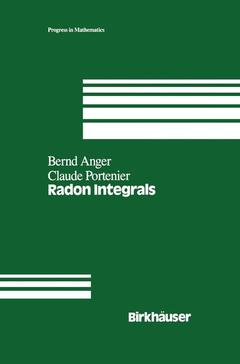Description
Radon Integrals, Softcover reprint of the original 1st ed. 1992
An abstract approach to integration and Riesz representation through function cones
Progress in Mathematics Series, Vol. 103
Authors: Anger B., Portenier C.
Language: English
Keywords
distribution; integral; integration; measure; measure theory; stability
Radon Integrals
Publication date: 02-1992
334 p. · 15.5x23.5 cm · Hardback
Publication date: 02-1992
334 p. · 15.5x23.5 cm · Hardback
Radon Integrals
Publication date: 12-2012
334 p. · 15.5x23.5 cm · Paperback
Publication date: 12-2012
334 p. · 15.5x23.5 cm · Paperback
Description
/li>Contents
/li>
In topological measure theory, Radon measures are the most important objects. In the context of locally compact spaces, there are two equivalent canonical definitions. As a set function, a Radon measure is an inner compact regular Borel measure, finite on compact sets. As a functional, it is simply a positive linear form, defined on the vector lattice of continuous real-valued functions with compact support. During the last few decades, in particular because of the developments of modem probability theory and mathematical physics, attention has been focussed on measures on general topological spaces which are no longer locally compact, e.g. spaces of continuous functions or Schwartz distributions. For a Radon measure on an arbitrary Hausdorff space, essentially three equivalent definitions have been proposed: As a set function, it was defined by L. Schwartz as an inner compact regular Borel measure which is locally bounded. G. Choquet considered it as a strongly additive right continuous content on the lattice of compact subsets. Following P.A. Meyer, N. Bourbaki defined a Radon measure as a locally uniformly bounded family of compatible positive linear forms, each defined on the vector lattice of continuous functions on some compact subset.
I. General Integration Theory.- II. Functional Analytic Aspects and Radon Integrals.- III. Set—Theoretical Aspects and Radon Measures.- § 16 Notes and special applications.- 16.1 Historical notes and comments.- 16.2 L.H. Loomis’ abstract Riemann integration theory.- 16.3 Representation theorem of H. Bauer.- 16.4 Measurability and integrability in the sense of N. Dunford and J.T. Schwartz, as developed by K.P.S. and M. Bhaskara Rao.- 16.5 H. Königs’ version of a basic measure extension theorem.- 16.6 Representation theorem of D. Pollard and F. Topsoe for cones of positive functions.- 16.7 Representation theorem of C. Berg, J.P.R. Christensen and P. Ressel for cones of positive functions.- 16.8 F. Topsoe’s representation theorem for cones of positive functions without stability w.r.t. positive differences.- 16.9 An abstract version of Henry’s extension theorem.- § 17 Hahn—Banach—Andenaes theorem for conoids.- Index of symbols.- References.
© 2024 LAVOISIER S.A.S.




